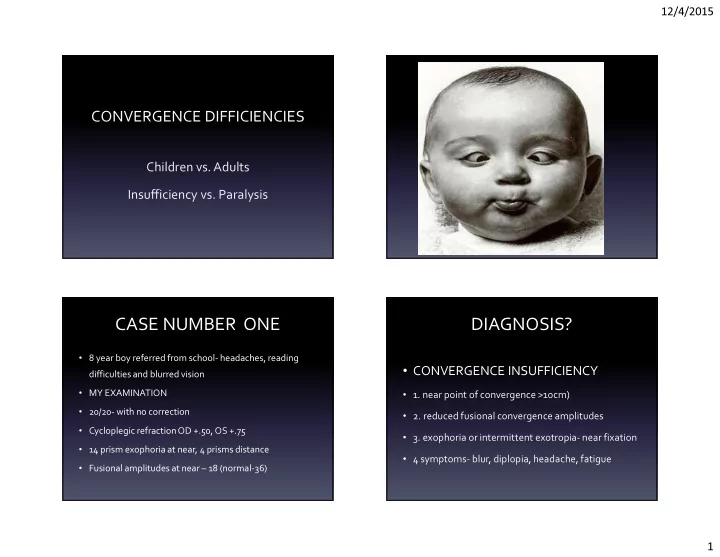

12/4/2015 CONVERGENCE DIFFICIENCIES Children vs. Adults Insufficiency vs. Paralysis CASE NUMBER ONE DIAGNOSIS? • 8 year boy referred from school- headaches, reading • CONVERGENCE INSUFFICIENCY difficulties and blurred vision • MY EXAMINATION • 1. near point of convergence >10cm) • 20/20- with no correction • 2. reduced fusional convergence amplitudes • Cycloplegic refraction OD +.50, OS +.75 • 3. exophoria or intermittent exotropia- near fixation • 14 prism exophoria at near, 4 prisms distance • 4 symptoms- blur, diplopia, headache, fatigue • Fusional amplitudes at near – 18 (normal-36) 1
12/4/2015 CONVERGENCE INSUFFICIENCY CONVERGENCE INSUFFICIENCY • Increasingly common as adults age • 1. affects 2.25-8.3% of normal children • 70% of adults >80 years have reduced convergence • 2. higher prevalence in attention deficit • Symptoms become progressively worse with age hyperactive disorder (ADHD) • Bifocals may precipitate symptoms • 3. head trauma, illness, stress, lack of sleep • Exercises less effective than in children may precipitate symptoms • Prisms usually required CASE NUMBER TWO CASE NUMBER TWO • 62 year old professor of surgery complaining of • Two years later- symptoms return difficulty reading- several pairs of readers • 18 prism exophoria – near; 2 prism XP – distance • 12 prism exophoria - near; 2 prism XP - distance • 11 prism – near convergence fusional amplitude • 15 prism - fusional amplitude at near • Near point of convergence 12 cm • Symptom-free with 3 diopters base in each lens • Symptom-free with 5 diopter base in each lens after no response to exercises • Upgaze noted to be reduced 50% 2
12/4/2015 CASE NUMBER TWO CONVERGENCE PARALYSIS • One year later- constant diplopia at near • Inability to converge • 16 prism exotropia – near; 3 prism XP distance • Exotropia at near • Near point of convergence- remote • Pupils may be normal or abnormal • Adduction - normal; pupils - normal • Upgaze also commonly involved • Upgaze limited – 75% • IMPLIES DORSAL MIDBRAIN DISORDER • Diagnosis: Convergence Paralysis CASE NUMBER TWO CONVERGENCE PARALYSIS • NEUROLOGIC CONDITIONS • 9 months latter: Parkinson’s disease • Parkinson’s • 1 year later- diagnosis changed to Progressive • Progressive supranuclear palsy Supranuclear Palsy • Tumors- midbrain/third ventricle • Now all eye movements are restricted- • Head trauma convergence, saccades and pursuits • Encephalitis 3
12/4/2015 Conclusions Conclusions • Convergence insufficiency- common • Convergence paralysis implies neurologic • Increasing problem over age 70 disease involving the midbrain • Treatment- exercises or prisms • Convergence paralysis is usually difficult to treat even with surgery • Convergence insufficiency may evolve to be • Follow carefully the patient with convergence convergence paralysis, especially in elderly “insufficiency” and deficiency of upgaze REFERENCES • 1. Ghadban R, Martinez JM, Diehl NN, Moheny BG. The incidence and clinical characteristics of adult-onset convergence insufficiency. Ophthalmology 2015; 122: 1056-9. “Divergence” Insufficiency • 2. Almer Z, Klein KS, Marsh L, et al. Ocular motor and sensory function in Parkinson disease. Ophthalmol 2012; 119: 172-82. • Bruce AS, Atchinson DA, Bhoola H. Accommodative- Not What The Name Implies convergence relationships and age. Invest OphthalmolVis Sci 1995; 36: 406-13. 4
12/4/2015 Interesting Case Interesting Case • 80 year old man- gradual onset diplopia • Mestinon pushed to toxicity- no effect • 6 prisms esotropia; ? mild limitation abduction OU • Prednisone 60mg/day- no effect • Eye/lid movements otherwise normal • Immunomodulation therapy x’s 2- no effect • MRI, myasthenia antibodies, blood work- normal • Thymectomy considered • Neurologic examination- normal • Maintained on prednisone- 6 years • Presumed diagnosis- myasthenia gravis • Diplopia persisted unchanged Interesting Case NOT MYASTHENIA • MY EXAMINATION: • No ptosis • 6 prisms esotropia- distance; small exophoria-near • No history of increase with fatigue • No limitation of abduction in either eye • No variability of strabismus • No ptosis • No response to any therapy • Patient has mild myopia- -2.00 sphere each eye • ! Most important- the pattern of his strabismus! 5
12/4/2015 “DIVERGENCE” INSUFFICIENCY “DIVERGENCE” INSUFFICIENCY • In contrast to convergence- no active brainstem divergence center has been identified • 1. Esotropia greater at distance than near • Jampolsky- “these are subclinical sixth nerve palsies” • 2. Decreased divergence fusional amplitudes • Abduction-saccadic velocities decreased • 3. Esotropia at distance- usually stable • CONCLUSION: “DIVERGENCE INSUFFICIENCY IS A • 4. Esotropia at near- all most never SERIOUS NEUROLOGIC PROBLEM? SERIOUS PROBLEM? REFERENCE • IN CHILDREN- YES! Herlihy EP, Phillips JO, Weiss AH. Esotropia greater at distance. Children vs. Adults. JAMA Ophthalmology 2013; 131 (3):370-5 • 14/15 - serious neurologic associations NOTE: Most of the children did not have clinically • Hydrocephalus, meningitis, brain tumors, evident lateral incomitance suggesting a sixth nerve Guillain-Barre syndrome (descending palsy; eye movement recordings- reduced saccades polyneuropathy), encephalocele 6
12/4/2015 SERIOUS PROBLEM? CONCLUSIONS • IN ADULTS- NO! • “Divergence” insufficiency is a misnomer • 4/17- serious neurologic associations • Preferred “EsotropiaGreater at Distance” • In Children- strongly suggests neurologic problem • BUT all of the patients with neurologic disorders • In Adults over 60 as an isolated finding- benign had other neurologic findings- nystagmus in all 4. • Treatment- prisms in most patients; surgery References • 1. JampolskyA. Ocular divergence mechanisms. Trans Am Ophthalmol Soc 1970;68:730-822. • 2. Godts D, Mathysen DG. Distance esotropia in the elderly. Br J Ophthalmol 2013; 97: 1415-9. • 3. Guyton DL. Changes in strabismus over time; the role of vergence tonus and muscle length adaptation. Bin Vis Strabismus Q. 2006; 21: 81-92. 7
Recommend
More recommend